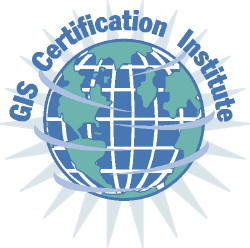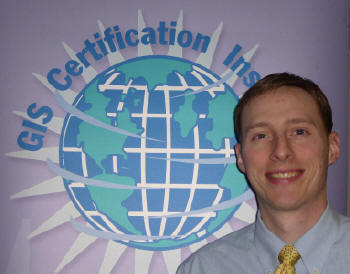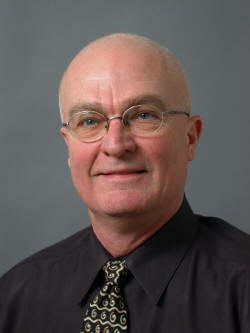 The GIS
Certification Institute finished its pilot
program in the last weeks of 2003 and launched the official program in
January 2004. Two years later, more than 1,000 individuals have
completed the certification process, which requires no testing, but
rather documenting a portfolio of academic study (EDU), professional
experience (EXP), and contribution to the profession (CON). They are
recognized as Certified GIS Professionals and hold the designation,
"GISP."
The GIS
Certification Institute finished its pilot
program in the last weeks of 2003 and launched the official program in
January 2004. Two years later, more than 1,000 individuals have
completed the certification process, which requires no testing, but
rather documenting a portfolio of academic study (EDU), professional
experience (EXP), and contribution to the profession (CON). They are
recognized as Certified GIS Professionals and hold the designation,
"GISP."To get a sense of what's happened during that period and what lies ahead, we put some questions to GISCI Executive Director Scott Grams; Chair of the GISCI Board of Directors Lynda Wayne, GISP, of GeoMaxim; and GISCI Board Member Bill Huxhold, GISP, a professor in the Department of Urban Planning at the University of Wisconsin-Milwaukee.
Directions Magazine (DM): What is the relationship between curriculum efforts at the university level and GISCI efforts regarding educational achievement?
 |
DM: How many attendees to the URISA conference regularly request to receive credits for attendance?
SG: This is difficult to determine. URISA hands out certificates of conference attendance. I would estimate that over 70% maintain these certificates for initial or recertification requirements. [At this time, during the "Transition Period," GISP educational achievement points via conference attendance do not require such formal documentation. That will change beginning in 2008.]
DM: Will you adjust any of the guidelines now that you have had a few years to review the results? Which guideline(s) if any have caused the greatest feedback, positive or negative?
SG: There have not been any glaring problems with the current program. The GISCI Oversight Committee has been broken down into four subcommittees that concentrate on the EDU, EXP, CON, and Recertification portions of the program. Some additional contributions categories may be added in 2006.
Volunteerism is one of the encouraging growth sectors in GIS, with GISCorps leading the way. The Contributions to the Profession Subcommittee of the Oversight Committee is examining the creation of a separate category to better recognize these achievements.
The Educational Achievement subcommittee is looking at if a percentage of "soft skill" credit can be used for GISCI recertification. Courses on project management, leadership, public speaking, managing employees, etc. may receive a small percentage of credit to help recognize GIS managers and coordinators who now do a significant portion of people management in their GIS jobs.
DM: GISCI wanted to include more geospatially related organizations as member organizations. The Urban and Regional Information Systems Association (URISA), the National States Geographic Information Council (NSGIC), the Association of American Geographers (AAG) and UCGIS are currently listed as member organizations. What have these players brought to the table? What other organizations are being pursued or are interested?
SG: With the addition of UCGIS, the GISCI Board voted to make the Board of Directors completely egalitarian. Each Member Organization now appoints an equal number of representatives to the Board (two). The community of geospatial organizations is growing more collaborative. There may not be a return to the age of GIS/LIS [a GIS/LIS conference hosted by several professional organizations, which shut down in the 1990s] but groups are rediscovering the value of working together. If an association is being run correctly, its staff will be a little overstretched. It's the nature of the association business. These four organizations working together on GISCI have reduced the burden on that staff. GISCI can move forward strategically without spending all of its time processing paperwork.
Multilateralism is the defining characteristic of GISCI. Although URISA formed GISCI, certification belongs to the broader geospatial community. GISCI knew it would be limited in scope if it only went after state and local government GIS professionals. The Committee was made up of a variety of GIS practitioners from a variety of sectors and to maintain this balance, GISCI needed to operate in a similar fashion.
All four organizations bring a unique perspective to the Board. UCGIS is already making an impact with its ethics and Body of Knowledge contributions. AAG will feature a number of panels at its Annual Conference this year to discuss certification and ethics. NSGIC has been a strong supporter of the Institute and is well-equipped to report on the progress of GIS certification at the state level. URISA has the historical perspective of starting the effort. URISA deserves a lot of credit for following through on its initial promise to turn certification over to the geospatial community. That took courage and strong belief that what they started could survive on its own.
Currently, GISCI does not have an outstanding invitation for another Member Organization to join. The Board of Directors votes when an organization appears to be ready to lend its support to GISCI. However, the coverage of the geospatial community is far from complete. Eventually, all organizations with a focus in GIS and geospatial technology should have a place at the certification table.
 |
Lynda Wayne: My support for GISCI lies in its ability, as a federation of GIS professional organizations, to build and promote GIS as a profession.
Certification was a necessary first step. We are now pursuing professional development programs to address ethics, mentoring of young professionals, and various communication forums. It is through these and future efforts that I see GISCI making the greatest contributions to the profession of GIS.
DM: Since UCGIS supports the program, might the GISP be restructured at some point to be a certification available at college graduation?
SG: Currently, applicants must have at least 48 months of professional experience in order to apply. This precludes most graduates from earning the credential right out of school. If an applicant graduates from a degree program with a heavy emphasis on GIS they will be in good shape after they have earned their four years of experience and have made modest contributions to the field. Remember, not all applicants must have a degree in GIS or a related field. Course points can supplement a degree in any field as long as those course points are related to GIS.
DM: Two states (North Carolina and Oregon) have endorsed GISP certification. Do any yet require it for certain positions? Are more states looking to endorse it?
SG: The North Carolina and Oregon endorsements were unsolicited but not surprising. There are a number of states that have seen tremendous value in the program. Florida, California, Colorado, Michigan, Ohio, Texas, Virginia, Washington, Wisconsin, etc. all have gravitated toward the credential. North Carolina and Oregon have progressive geographic information councils who wanted to back their GIS professionals by removing any doubt or obstacles those professionals had regarding the GISP. NSGIC is an excellent organization that will keep GISCI informed if any further geographic information councils want to purse an endorsement.
DM: Have you tracked the number of employees requesting or advertising specifically for individuals with a GISP?
SG: This is difficult to track. We see cases on an anecdotal level but lack hard data.
DM: Has the Code of Ethics been an issue for individuals who have met the credentials? GISPs are required to sign. Have any refused? Have any consequences been determined for those who break the Code of Ethics?
SG: Currently, the GISCI Ethics Committee is finalizing a supplemental document to the Code of Ethics called the Rules of Conduct. This document takes a stronger stance on what type of behavior is expected of GISPs. This document will provide a more rigid structure for ethics violators. The two Codes are important because they add teeth and credibility to the GISCI program. Certified GIS professionals must put their credential at stake with each professional exchange. One agrees to abide by the Codes of Ethics and Rules of Conduct or the result may be the loss of his/her credential. A non-certified professional does not have this additional consideration. Unethical behavior in some instances may only result in a lack of respect or credibility for non-GISPs. For a GISP, unethical behavior could result in the loss of the tangible GISP credential. GISPs aspire to perform ethically and agree to face the consequences for dubious and inconsiderate actions.
DM: The number of GISPs now tops 1,000. Has the pace of applications slowed since the initial roll out?
SG: No. In fact, GISCI budgets for more and more applications each year. Obviously, the first few months of 2004 saw the biggest blips but we have not experienced a dry spell. GISCI is confident that professionals will continue to see the value in this alternative approach to professional certification.
DM: Has GISCI found a role in the Department of Labor's work to grow a next generation of geospatial professionals?
SG: GISCI has spoken with the Department of Labor (DOL) about how the two programs relate. GISCI receives numerous calls and emails about how to get started in GIS. We inform them that we offer a "certification" program and not a "certificate" program. A certificate program involves taking courses as part of a curriculum. A certification program is a professional recognition program for established professionals in the field.
Given the 48 month experience requirement, the two programs link together well. A professional new to the field is educated through the DOL's program while being paid. After that, if a professional has worked long enough, completed the education, made modest contributions to the field, and met the requirements of the GISCI program, they can receive the GISP. The DOL's program comes before ours and both give aspiring professionals guidance.
DM: Two years after rollout, what are GISCI's biggest challenges?
SG: The biggest challenge continues to be educating professionals about the program. If I had a dime for every person who has told me "it is sitting on my desk," I would retire in Tahiti. Most people are overwhelmed by the size and depth of the application. Also, applicants who did not retain necessary documentation get discouraged. It is GISCI's job to explain the process clearly, so those considering applying avoid hesitation.
Second, recertification once seemed like it was 100 years into an uncertain future. Now, it is right around the corner [in 2008]. The Oversight and Outreach Committees have a lot of work to make sure applicants are aware of the recertification requirements. Recertification is not something an applicant can wait until the last minute to accomplish. Points should be earned incrementally and mirror the initial application. Recertification, like initial certification, rewards active professionals.
Third, we must find additional Member Organizations. Not all organizations are ready to commit to GISCI. It is the challenge of the present Board to enhance itself with members from associations and organizations ready to accept the responsibility of promoting professional certification. Some organizations prefer to remain impartial observers to the effort. GISCI is an active organization. The Board and Committees meet tirelessly. Any Board member can attest that this is not something to be undertaken in an organization's spare time. The groups who remain hesitant about promoting certification to their membership because they think GISCI will fall on its face, may soon find themselves staring at the back of GISCI as the issue passes them by.
Fourth, we need to highlight how certification is being valued within the professional community. Value means different things to different people. Some look for a financial incentive. Others see the benefits of the credential more intrinsically. GISCI now features testimonials on the website where GISPs can explain what the credential means to them. GISCI needs to listen to its GISPs. The benefit of any credential is what it represents and not the letters themselves. Highlighting the achievements of GISPs is the best way to promote the Institute.
BH: As far as GISCI's next biggest challenges, I am sure that the development of a recertification program would be high on my list. We have only three more years to finalize that.
DM: What do you see as your next actions to promote certification?
SG: GISCI needs to increase its presence in the geospatial community. We now have a network of over 1,000 GISPs who can accurately detail the application process. GISCI needs to rely more heavily on these stewards of the program to educate the "tire kickers." GIS Professionals are part of a community unlike anything else. The primary reason GIS professionals pursue certification is because of their colleagues. Some organizations even send in a pack of six or eight applications after spending an afternoon helping each other fill them out. GISCI can have the best marketing plan in the world, but it is no match for one GIS professional talking to another in the corridors of a conference or break room on the job.
Over 1,000 GISPs later and I feel we are just getting started.
BH: I feel that we need to continue to open up opportunities for it to promote itself. Take, for example, the outreach committee we have of current GISPs. They are an active, energetic group that is doing a great job letting people know the value they have realized in being a GIS professional. They are self-motivated - GISCI only provided the opportunity. Also, as more organizations become board members, their members will become more exposed to the value of being a GISP. And, finally, we need to let the youth of this nation know how valuable the GIS career is to us, and help them understand what it takes to become a valued, ethical GIS professional, so that they can be more knowledgeable in making career choices.